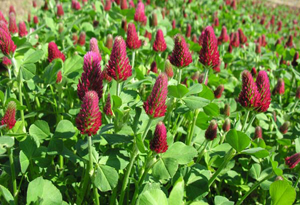| HOME > View Blog > |
View Blog
Wednesday, Feb 15, 2017 12:00am

Crimson Clover (Trifolium incarnatum)

Crimson Clover is a cool season, reseeding annual legume. It draws its name from its brilliant crimson flowers.
It is a palatable and nutritious deer forage. Wild Turkey consume it as greens and it provides bugging habitat for poults. Peak production is in early spring. It is about half the cost of perennial clovers.
It is widely adapted across the Southern US. It is more tolerant of poor soils than other clovers. It will tolerate a wide range of soil pH 5.7-7.0 but prefers soil with a pH from 6.0 to 6.7. It does best on well-drained sandy loams to heavy clays. It is moderately shade tolerant.
Plant September-October. Because Crimson Clover is a legume, the seed should be inoculated with Rhizobium bacteria (Strain R) before it is planted. Broadcast seed at a rate of 30 lbs. per acre. Cover seed no more than ¼ inch. In the absence of a soil test, fertilize with 100 lbs. per acre of 0-30-30 fertilizer at establishment.
Seedbed preparation is very important when planting small seeds. Disk and then smooth the seed bed by rolling with a cultipacker or dragging with a drag harrow. Do not disk seed in. Roll the seed with a cultipacker or lightly drag the seed in with a drag harrow.
Clover is often planted in combination with cereal grains such as oats, wheat or rye. When planting in combination with cereal grains we recommend planting clover with Elbon Rye. When planting in combination with Elbon Rye decrease the clover seeding rate by ½. Do not mix the clover and cereal grain seeds together when broadcasting the seed. The smaller clover seed will settle to the bottom of the seeder and will not be evenly distributed. Seed the Elbon Rye first and then over seed the food plot with the clover seed. After seeding cover the Clover and Elbon Rye mixture to a depth of no more than ¼ inch by lightly dragging with a drag harrow. In the absence of a soil test, fertilize with 300 lbs. per acre of 13-13-13 fertilizer at establishment.
